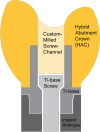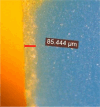Internal fit and marginal adaptation of all-ceramic implant-supported hybrid abutment crowns with custom-milled screw-channels on Titanium-base: in-vitro study
- PMID: 39261788
- PMCID: PMC11391652
- DOI: 10.1186/s12903-024-04810-9
Internal fit and marginal adaptation of all-ceramic implant-supported hybrid abutment crowns with custom-milled screw-channels on Titanium-base: in-vitro study
Abstract
Background: Advancements in digital dentistry helped in custom-milling screw-channels in implant-supported restorations; however, the fit of these restorations is still unclear especially for contemporary computer aided designing/computer aided manufacturing (CAD/CAM) materials. This study aimed to compare the internal and marginal fit of Ultra translucent multilayered zirconia versus lithium disilicate implant-supported hybrid abutment crowns (HACs) constructed with custom-milled screw-channels on Titanium-base.
Materials and methods: A total of 24 HACs with custom-milled screw-channels were constructed from lithium disilicate (Group LDS) and Ultra translucent multilayered zirconia (Group UT) using digital workflow (n = 12). The internal and marginal gaps of HACs on their corresponding Titanium-bases were assessed using replica technique and stereomicroscope, respectively. After testing for normality, quantitative data were expressed as mean and standard deviation and compared using independent t-test at a level of significance (P ≤ 0.05).
Results: There was no statistically significant difference between Group LDS and Group UT in terms of marginal and internal fit. The internal and marginal gaps in both groups were within the accepted values reported in literature.
Conclusions: UT and LDS HACs with custom-milled screw-channels demonstrated comparable and acceptable internal fit and marginal adaptations to Ti-base, which lied within the range reported in literature.
Keywords: CAD/CAM; Lithium disilicate; Replica; Stereomicroscope; Ultra translucent zirconia.
© 2024. The Author(s).
Conflict of interest statement
The authors declare no competing interests.
Figures





Similar articles
-
Failure Load of Monolithic Lithium Disilicate Implant-Supported Single Crowns Bonded to Ti-base Abutments versus to Customized Ceramic Abutments after Fatigue.J Prosthodont. 2022 Feb;31(2):136-146. doi: 10.1111/jopr.13369. Epub 2021 May 4. J Prosthodont. 2022. PMID: 33870577
-
Effect of feldspathic porcelain layering on the marginal fit of zirconia and titanium complete-arch fixed implant-supported frameworks.J Prosthet Dent. 2018 Jul;120(1):71-78. doi: 10.1016/j.prosdent.2017.11.003. Epub 2018 Feb 6. J Prosthet Dent. 2018. PMID: 29426786
-
Impact of implant abutment materials on force damping response and marginal fit of implant supported restoration.BMC Oral Health. 2025 May 20;25(1):738. doi: 10.1186/s12903-025-06112-0. BMC Oral Health. 2025. PMID: 40389955 Free PMC article.
-
Material and abutment selection for CAD/CAM implant-supported fixed dental prostheses in partially edentulous patients - A narrative review.Clin Oral Implants Res. 2024 Aug;35(8):984-999. doi: 10.1111/clr.14315. Epub 2024 Jun 12. Clin Oral Implants Res. 2024. PMID: 38864592 Review.
-
Evaluation of marginal and internal fit of lithium disilicate and zirconia all-ceramic CAD-CAM crowns using digital impressions: A systematic review.Prim Dent J. 2023 Mar;12(1):88-95. doi: 10.1177/20501684231154323. Prim Dent J. 2023. PMID: 36916623
Cited by
-
Comparison of the Internal and Marginal Adaptation of Implant-Supported Restorations on Titanium Base Using Various Materials: An In Vitro Study.Materials (Basel). 2025 Apr 1;18(7):1590. doi: 10.3390/ma18071590. Materials (Basel). 2025. PMID: 40271820 Free PMC article.
References
-
- Yıldız P, Alkan Demetoğlu G, Talay Çevlik E. Effect of cement type on vertical marginal discrepancy and residual excess cement in screwmentable and cementable implant-supported monolithic zirconia crowns. Odontology. 2024. Epub ahead of print. [cited 2024 Aug 5]. Available from: https://pubmed.ncbi.nlm.nih.gov/38634968/. - PubMed
-
- Sami R. Marginal adaptation of various CAD/CAM all-ceramic superstructures cemented on ready and custom made zirconia abutments. Egypt Dent J. 2017;63(2):1801–18.10.21608/edj.2017.75135 - DOI
Publication types
MeSH terms
Substances
LinkOut - more resources
Full Text Sources
Miscellaneous

